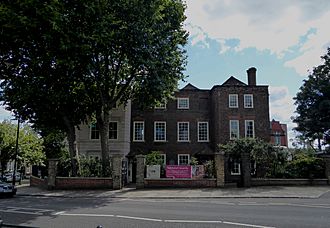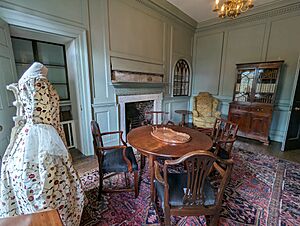Sutton House, London facts for kids
Quick facts for kids Sutton House |
|
|---|---|

Sutton House, the oldest house in Hackney
|
|
| Former names | Bryck Place |
| General information | |
| Type | Manor house |
| Architectural style | Tudor |
| Location | Homerton High Street London, E9 United Kingdom |
| Coordinates | 51°32′54″N 0°3′1″W / 51.54833°N 0.05028°W |
| Completed | 1535 |
| Renovated | 1993 |
| Client | Sir Ralph Sadler |
| Owner | National Trust |
| Technical details | |
| Material | Red brick |
|
Listed Building – Grade II*
|
|
| Designated | 23 April 1951 |
| Reference no. | 1226810 |
Sutton House is a very old and special house in Homerton High Street, in Hackney, London, England. It's a Tudor manor house, which means it was built a long time ago during the time of the Tudors. It's so important that it's a "Grade II* listed building," meaning it's protected because of its history. Today, the National Trust looks after Sutton House.
Contents
History of Sutton House
The 1500s: Building a New Home
Sutton House was first called Bryck Place. It was built in 1535 by a man named Sir Ralph Sadler. He was a very important person, working as the Principal Secretary of State for King Henry VIII. This makes Sutton House the oldest house in Hackney.
It's a special example of a red-brick building from the Tudor period. When it was first built, it had three floors and was shaped like the letter "H." In 1550, Sir Ralph Sadler sold the house and the land around it. He had built an even bigger house somewhere else.
The new owner was John Machell, who was a successful cloth merchant. He used Sutton House as a quiet place to relax away from his main home in London. The beautiful wooden panels in the parlour, which look like folded linen, were probably put in when he owned the house. John Machell passed away in 1558. The house then went to his wife, Joan, and his oldest son, also named John.
Young John Machell wasn't as good with money as his father. He eventually lost the house in the early 1600s to James Deane, another merchant.
The 1600s: Schools and New Owners
After James Deane died, the house went to his niece, Olive. She likely rented it out to different people. In the early 1630s, the house was sold to John Milward. He was a wine merchant and later traded silk for the East India Company.
John Milward also had money problems. In 1639, he gave the house to his daughter Elizabeth and her husband, Edward Abbot. Edward was also involved with the East India Company. But he too faced money troubles and lost the house.
In the 1650s, Henry Whittingham bought the house. He then rented it to a wealthy widow named Sarah Freeman. In 1657, Sarah Freeman opened a boarding school for girls at Sutton House. This school was very well-known and she ran it until she died in 1700. The house then passed down through Henry Whittingham's family.
The 1700s: Changes and Divisions
After Sarah Freeman's death, the girls' school continued until 1740. Then, a builder named John Cox rented the house. He updated it and later divided it into smaller parts. By the 1750s, two different people were living there, which shows the house had been split up.
During this time, new windows were put in, and parts of the house were updated with a more modern "Georgian" style. Many new homes were built in the streets nearby, changing the area. The Ball family then owned Sutton House for many years. During their time, different Huguenot families, who were French Protestants, lived in the house.
The 1800s: More Schools and Preservation Efforts
In 1816, a Reverend named Thomas Burnet bought the house to open a boys' school. Famous writer Edward Bulwer-Lytton and Frederick Young went to school there. After that, it became Milford House girls' school, which stayed open until 1875.
Over the years, who legally owned parts of the house became very complicated. In the mid-1800s, a court had to decide that the western half of the property was indeed Sutton House. More and more houses were built around Sutton House, changing the neighborhood.
In the 1890s, the two halves of the estate, known as Picton House and Milford House, were bought by the Church of St John-at-Hackney. They wanted to create a place for men to gather. In 1898, an artist named Fleetwood Varley drew pictures of Sutton House. He did this for a group that wanted to save old buildings. In 1904, the house was greatly repaired after the London County Council said it was unsafe the year before.
The 1900s: War and Neglect
The National Trust bought Sutton House in the 1930s. They used money given by William Alexander Robertson, who wanted to remember his two brothers who died in World War I. During World War II, the house was used by Fire Wardens. These brave people watched from the roof to spot fires caused by bombs.
After the war, the National Trust didn't focus much on Sutton House. They were busy with other big country houses. From the 1960s, a union rented the house. When the union left in the early 1980s, the house started to fall apart.
Saving Sutton House
In the mid-1980s, some people lived in the building without permission. It became a place for music and social events, known as the Blue House. A decorated wall from this time is still kept in the museum today.
After these people left, the house continued to get worse. But a group called the Sutton House Society, which started in 1987, began a campaign to save the building. They wanted to fix it up and open it to the public. The main repairs were finished in 1991.
The house was fully opened to the public in 1994. Today, Sutton House is a museum. It also has a café, an art gallery, and a shop. There are special programs for schools and other community groups. Sutton House was even considered for a big award, the Gulbenkian Prize, in 2004. You can also get married there!
Getting to Sutton House
The easiest way to get to Sutton House by train is to go to Hackney Central station or Homerton station. These are both on the North London Line, which is part of the London Overground network. Many buses also stop nearby.






